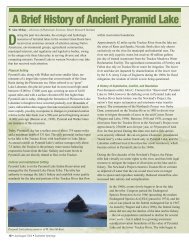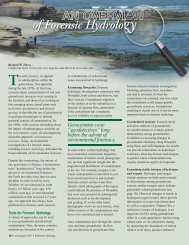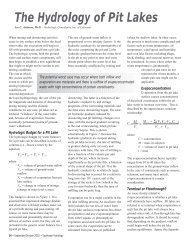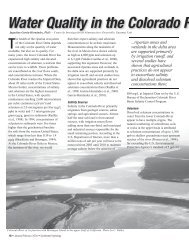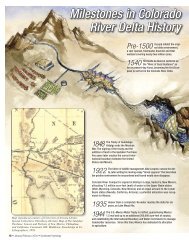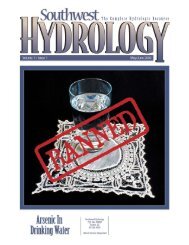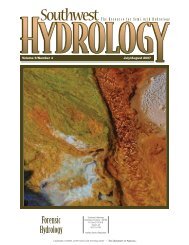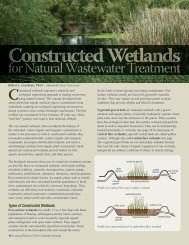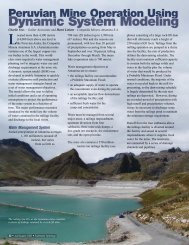Produced Water Reuse at the Kern River Oil Field - Southwest ...
Produced Water Reuse at the Kern River Oil Field - Southwest ...
Produced Water Reuse at the Kern River Oil Field - Southwest ...
You also want an ePaper? Increase the reach of your titles
YUMPU automatically turns print PDFs into web optimized ePapers that Google loves.
<strong>Produced</strong> <strong>W<strong>at</strong>er</strong> <strong>Reuse</strong><br />
<strong>at</strong> <strong>the</strong> <strong>Kern</strong> <strong>River</strong> <strong>Oil</strong> <strong>Field</strong><br />
Jim Waldron, R.G., C.Hg. – Chevron U.S.A. Inc., Bakersfield, CA<br />
Loc<strong>at</strong>ed along <strong>the</strong> sou<strong>the</strong>astern edge of <strong>the</strong> San Joaquin<br />
Valley is <strong>the</strong> giant <strong>Kern</strong> <strong>River</strong> oil field. With humble<br />
origins – it was discovered in 1899 in a 45-foot shaft dug<br />
with shovels – this oil field originally contained approxim<strong>at</strong>ely 4<br />
billion barrels of oil (1 barrel = 42 gallons). The discovery of <strong>the</strong><br />
field started an oil boom in <strong>Kern</strong> County th<strong>at</strong> continues today.<br />
Much of <strong>the</strong> field’s high-viscosity<br />
“heavy” oil is produced from shallow<br />
fluvial deposits of <strong>the</strong> l<strong>at</strong>e Miocene<br />
to Pleistocene <strong>Kern</strong><br />
<strong>River</strong> Form<strong>at</strong>ion. The<br />
productive oil interval<br />
ranges from less<br />
than 100 feet deep to<br />
approxim<strong>at</strong>ely 1,600<br />
feet deep. Through<br />
2003, approxim<strong>at</strong>ely<br />
1.8 billion barrels of<br />
oil had been produced.<br />
Production has remained<br />
rel<strong>at</strong>ively constant for <strong>the</strong><br />
past five years, <strong>at</strong> more than<br />
San<br />
Francisco<br />
Bakersfield<br />
100,000 barrels per day (DOGGR,<br />
2003). More than 90 percent of <strong>the</strong> estim<strong>at</strong>ed ultim<strong>at</strong>e 2-billion<br />
barrel recovery will have been accomplished with steamassisted,<br />
secondary recovery production processes. The <strong>Kern</strong><br />
<strong>River</strong> oil field is one of <strong>the</strong> world’s largest steam-flood oil<br />
projects and <strong>the</strong> sixth largest oil field in <strong>the</strong> United St<strong>at</strong>es.<br />
<strong>Kern</strong> Hydrology<br />
Hydrologically, <strong>the</strong> field is loc<strong>at</strong>ed<br />
near <strong>the</strong> mouth of <strong>Kern</strong> <strong>River</strong> Canyon<br />
on <strong>the</strong> <strong>Kern</strong> <strong>River</strong> alluvial fan, a<br />
huge fan-shaped wedge of sand and<br />
gravel on <strong>the</strong> east side of <strong>the</strong> San<br />
Joaquin Valley th<strong>at</strong> forms where <strong>the</strong><br />
bicarbon<strong>at</strong>e-rich w<strong>at</strong>ers of <strong>the</strong> <strong>Kern</strong><br />
<strong>River</strong> exit <strong>the</strong> Sierra Nevada foothills.<br />
This is <strong>the</strong> main g<strong>at</strong>eway through<br />
which much of <strong>the</strong> w<strong>at</strong>er th<strong>at</strong> recharges<br />
<strong>the</strong> valley’s shallow aquifers flows.<br />
Los Angeles<br />
Through a long-term<br />
contract …, <strong>the</strong> w<strong>at</strong>er<br />
district is able to buy<br />
millions of barrels<br />
of w<strong>at</strong>er <strong>at</strong> a very<br />
reasonable price.<br />
The principal aquifer in <strong>the</strong> <strong>Kern</strong> <strong>River</strong> field is an unconfined<br />
aquifer comprised of <strong>the</strong> lower <strong>Kern</strong> <strong>River</strong> and upper Chanac<br />
form<strong>at</strong>ions. This aquifer is overlain by several perched aquifers<br />
within <strong>the</strong> upper <strong>Kern</strong> <strong>River</strong> Form<strong>at</strong>ion. Underlying <strong>the</strong><br />
unconfined aquifer are several confined aquifers in <strong>the</strong> lower<br />
Chanac and Santa Margarita form<strong>at</strong>ions th<strong>at</strong> do not appear to<br />
be hydraulically connected to <strong>the</strong> unconfined aquifer (Coburn,<br />
1997). The potentiometric surface in <strong>the</strong> regional unconfined<br />
aquifer and <strong>the</strong> smaller perched aquifers dip westerly and are<br />
parallel to <strong>the</strong> structural dip of <strong>the</strong> <strong>Kern</strong> <strong>River</strong> Form<strong>at</strong>ion.<br />
Extensive fluid<br />
depletion in<br />
zones along<br />
<strong>the</strong> up-dip<br />
edge of <strong>the</strong><br />
field and<br />
<strong>the</strong> lack of a<br />
potentiometric<br />
gradient<br />
showing<br />
flow outward<br />
from <strong>the</strong> <strong>Kern</strong> <strong>River</strong> suggest <strong>the</strong>re is minimal<br />
groundw<strong>at</strong>er recharge in <strong>the</strong> <strong>Kern</strong> <strong>River</strong> field from<br />
n<strong>at</strong>ural sources, including <strong>the</strong> <strong>Kern</strong> <strong>River</strong> (Coburn, 1997).<br />
With <strong>Oil</strong> Comes <strong>W<strong>at</strong>er</strong><br />
In m<strong>at</strong>ure oil fields with high w<strong>at</strong>er-to-oil recovery r<strong>at</strong>ios th<strong>at</strong><br />
use steam as <strong>the</strong> primary recovery technique, w<strong>at</strong>er is <strong>the</strong><br />
result—lots of it! Steam is injected as vapor into <strong>the</strong> <strong>Kern</strong><br />
<strong>River</strong> Form<strong>at</strong>ion, where it he<strong>at</strong>s <strong>the</strong> oil to lower <strong>the</strong> viscosity.<br />
The steam condenses and occupies part of <strong>the</strong> pore space th<strong>at</strong><br />
is effectively produced on a daily basis. Because <strong>the</strong> steam<br />
and <strong>the</strong> produced w<strong>at</strong>er are geochemically<br />
equivalent, it is difficult to know how much<br />
recycling actually takes place. But about nine<br />
barrels of w<strong>at</strong>er are produced along with every<br />
barrel of oil. Therefore, over 900,000 barrels, or<br />
116 acre-feet of w<strong>at</strong>er are produced each day.<br />
Chevron reclaims about half of this w<strong>at</strong>er to<br />
gener<strong>at</strong>e new steam to enhance oil production and<br />
for o<strong>the</strong>r in-field uses. However, <strong>the</strong> remaining<br />
w<strong>at</strong>er, approxim<strong>at</strong>ely 58 acre-feet, represents<br />
wh<strong>at</strong> would normally be a costly disposal<br />
problem and potentially wasteful use of w<strong>at</strong>er.<br />
Various degrees of tre<strong>at</strong>ment of produced w<strong>at</strong>er are often<br />
required prior to any discharge for agricultural use. But<br />
produced w<strong>at</strong>er from <strong>the</strong> <strong>Kern</strong> <strong>River</strong> oil field is uniquely of very<br />
high quality and contains a minimal amount of dissolved solids<br />
26 • November/December 2005 • <strong>Southwest</strong> Hydrology
and metals. To tre<strong>at</strong><br />
any hydrocarbons<br />
th<strong>at</strong> may be left in <strong>the</strong><br />
w<strong>at</strong>er after flot<strong>at</strong>ion<br />
and mechanical<br />
separ<strong>at</strong>ion, <strong>the</strong><br />
produced w<strong>at</strong>er is<br />
filtered through large<br />
walnut shell-filled<br />
filters. The shells<br />
have exceptional<br />
surface characteristics<br />
for coalescing<br />
and filtr<strong>at</strong>ion, plus<br />
excellent resilience<br />
to wear and tear.<br />
Chevron conducts<br />
a rigorous w<strong>at</strong>ermonitoring<br />
program<br />
to ensure <strong>the</strong> quality<br />
of its produced w<strong>at</strong>er<br />
prior to discharge.<br />
Discharge is<br />
governed by N<strong>at</strong>ional<br />
Pollutant Discharge<br />
Elimin<strong>at</strong>ion System<br />
permits overseen by <strong>the</strong><br />
California St<strong>at</strong>e <strong>W<strong>at</strong>er</strong><br />
Resources Control<br />
<br />
<br />
<br />
Board. Any devi<strong>at</strong>ion from <strong>the</strong> standards<br />
can result in a substantial fine by <strong>the</strong> st<strong>at</strong>e.<br />
Two discharge points currently exist for<br />
<strong>the</strong> excess produced w<strong>at</strong>er: <strong>the</strong> Beardsley<br />
Canal, oper<strong>at</strong>ed by <strong>the</strong> North <strong>Kern</strong> <strong>W<strong>at</strong>er</strong><br />
Storage District, and a pipeline to <strong>the</strong><br />
Cawelo <strong>W<strong>at</strong>er</strong> District. Both discharge<br />
points convey excess produced w<strong>at</strong>er<br />
strictly for agricultural use. Historically,<br />
<strong>the</strong> Beardsley Canal was <strong>the</strong> sole<br />
discharge point for all w<strong>at</strong>er leaving <strong>the</strong><br />
oil field; however, in <strong>the</strong> early 1990s it<br />
became apparent th<strong>at</strong> ano<strong>the</strong>r discharge<br />
point would be required to handle <strong>the</strong><br />
ever-increasing volume of produced w<strong>at</strong>er.<br />
A User is Found<br />
Just a few miles from <strong>the</strong> oil field,<br />
Chevron (<strong>the</strong>n Texaco) learned th<strong>at</strong> valley<br />
farmers needed additional w<strong>at</strong>er for<br />
irrig<strong>at</strong>ion. After lengthy discussions, <strong>the</strong><br />
Cawelo <strong>W<strong>at</strong>er</strong> District recognized th<strong>at</strong><br />
Chevron’s excess produced w<strong>at</strong>er was a<br />
safe and reliable source of agricultural<br />
<br />
<br />
<br />
<br />
<br />
<br />
<br />
<br />
<br />
<br />
<br />
<br />
<br />
<br />
<br />
<br />
<br />
<br />
<br />
<br />
<strong>Kern</strong> <strong>River</strong> field produced w<strong>at</strong>er system schem<strong>at</strong>ic and reservoir for<br />
produced w<strong>at</strong>er for Cowelo <strong>W<strong>at</strong>er</strong> District.<br />
w<strong>at</strong>er and in 1994 signed a long-term<br />
conserv<strong>at</strong>ion agreement with Chevron.<br />
Cawelo <strong>the</strong>n had an 8.5-mile pipeline<br />
permitted and built to connect its local<br />
reservoir with <strong>the</strong> <strong>Kern</strong> <strong>River</strong> oil field.<br />
Chevron spent about $1.8 million to<br />
build a pump st<strong>at</strong>ion to deliver <strong>the</strong> w<strong>at</strong>er<br />
into <strong>the</strong> pipeline. Through a long-term<br />
contract th<strong>at</strong> was signed in 1996 and<br />
runs through 2011, <strong>the</strong> w<strong>at</strong>er district is<br />
able to buy millions of barrels of w<strong>at</strong>er<br />
<strong>at</strong> a very reasonable price. Chevron and<br />
Cawelo are also jointly exploring <strong>the</strong><br />
innov<strong>at</strong>ive use of constructed wetlands<br />
to fur<strong>the</strong>r tre<strong>at</strong> produced w<strong>at</strong>er for<br />
agricultural reuse. This pilot project is<br />
in its third year and shows gre<strong>at</strong> promise<br />
in reducing residual organic compounds<br />
to very low or nondetectable levels.<br />
Local farming interests in this semiarid<br />
region of California use blended<br />
excess produced w<strong>at</strong>er to irrig<strong>at</strong>e over<br />
46,000 acres of crops, including grapes,<br />
citrus, almonds, and pistachios. Blending<br />
with fresh w<strong>at</strong>er sources is required to<br />
lower <strong>the</strong> concentr<strong>at</strong>ion of boron from<br />
<br />
n<strong>at</strong>urally occurring levels of about<br />
1.0 milligram per liter (mg/l) to<br />
below 0.5 mg/l, to avoid any leaf<br />
or plant damage. This unique<br />
and novel venture cre<strong>at</strong>es a longterm,<br />
economical use of excess<br />
produced w<strong>at</strong>er and achieves <strong>the</strong><br />
mutual goals of Chevron and<br />
Cawelo. The project also stresses<br />
<strong>the</strong> importance of maximizing<br />
fresh-w<strong>at</strong>er resources through<br />
cooper<strong>at</strong>ive efforts among public<br />
agencies and priv<strong>at</strong>e industries.<br />
John Jones, former manager of<br />
<strong>the</strong> Cawelo <strong>W<strong>at</strong>er</strong> District, st<strong>at</strong>ed,<br />
“This is a major conserv<strong>at</strong>ion<br />
project for us. It’s a resource th<strong>at</strong><br />
we knew was <strong>the</strong>re.” It is a “winwin”<br />
situ<strong>at</strong>ion for both entities.<br />
References...................................<br />
Coburn, M.G., and J.M. Gillespie, 1997.<br />
Aquifer architecture of <strong>the</strong> <strong>Kern</strong> <strong>River</strong>,<br />
Chanac and Santa Margarita form<strong>at</strong>ions<br />
in <strong>the</strong> <strong>Kern</strong> <strong>River</strong> <strong>Field</strong>, California, Am.<br />
Assoc. of Pet. Geol., 81: 682.<br />
DOGGR (California Division of <strong>Oil</strong>, Gas and<br />
Geo<strong>the</strong>rmal Resources) Annual Report, 2003.<br />
November/December 2005 • <strong>Southwest</strong> Hydrology • 27



